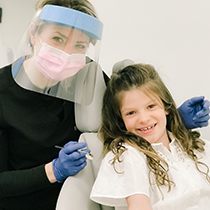There are good reasons why we should see your child’s smile for an early Orthodontic visit, so read on to find out why. An early appointment to check your child’s smile with our Orthodontists, Dr. Sarah Davidson, Dr. Dan Stuart or Dr. Declan Hennessey at The Brace Space, provides valuable information as to whether your child needs, early intervention, braces or Invisalign in their future.
It also assures you, as the parents, that you are doing the best thing possible by having your child’s bite and smile monitored by specialists.
Recommendations:
Why do the Canadian and American Association of Orthodontists recommend that children first be seen at the age of 7 or 8? It is because if early intervention is indicated, this is the best time to do it.
If a potential problem is identified, your Orthodontist will suggest monitoring your child. This monitoring is free of charge, at a regular interval (often yearly) until a time that treatment is indicated.
Usually orthodontic treatment is recommended around age 11-12 when the main growth spurt happens because many of the permanent teeth are present. In some cases early treatment is necessary.
Early, interceptive treatment may prevent a problem from becoming more serious. (possibly requiring surgery) It may achieve results that would otherwise be unattainable if treatment is delayed. In frequent cases it’s a ‘stitch in time’ scenario and it is heartbreaking to have to tell parents that their child could have benefited from an early visit, when it is too late.
What to look for:
So, for example, what do you look for? A developing smile can be a bit intimidating from a parent’s perspective, but there are some “bad bites” (or malocclusions) to watch for.
- an underbite (bottom teeth bite over top teeth)
- a crossbite (top teeth bite inside bottom teeth on one or both sides)
- a deep bite (top teeth completely cover bottom teeth)
- an open bite (teeth don’t come together in front)
- protrusion (“buck teeth”), excessive spacing or crowding
- any of the following:
– early or late loss of baby teeth
– difficulty chewing or biting
– mouth breathing
– a thumb or finger sucking habit
– jaws that shift or make sounds
– grinding or clenching of teeth
– biting the cheek or the roof of the mouth
– speech difficulties or facial imbalance.
Your next step:
Don’t be alarmed if you see one or more of these features in your child’s bite, because many changes occur as a child grows and some problems are temporary.
However, mentioning your finding at your child’s next regular dental visit is the best idea. Your Dentist is an excellent resource and will likely refer you to an Orthodontist as they see fit. Although not required, a referral from your Dentist is recommended, as your Orthodontist will want to work with your Dentist to ensure the best overall care and results for you or your child.
Come visit us at The Brace Space, we will answer your questions and monitor your child’s bite, to ensure the best possible outcome for their beautiful, healthy smile!

7 or 8 is the perfect age to see Orthodontist, Dr. Sarah Davidson

An underbite (bottom teeth bite over top teeth)

A deep bite (top teeth completely cover bottom teeth)